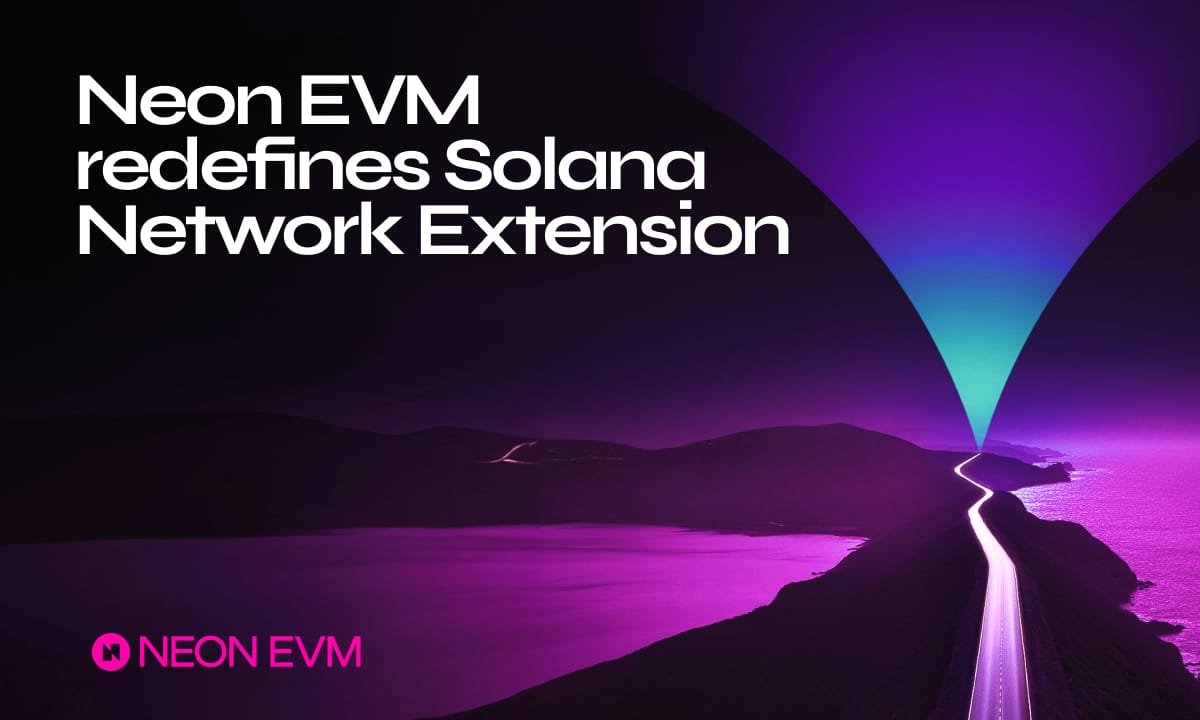London, UK, October 16, 2024, Chainwire
Neon EVM pioneered the network expansion category for Solana, ushering in a new era of integrated growth.
Solana’s leading Ethereum Virtual Machine (EVM), Neon EVM, has officially adopted the Solana Network Extension as a product category, perfectly capturing the essence of this new category. Network expansion fills an important gap in the Solana ecosystem. Neon EVM provides clarity for developers, investors, and users alike by providing formal categories for projects that natively extend the functionality of Solana.
Traditionally, positioning has been driven by the unique characteristics of Neon EVM and various other projects (MagicBlock, MetaPlex, etc.). This is because it is not a typical layer 1 or layer 2 blockchain.
Unlike traditional rollups, L2s, or sidechains, Neon EVM is a program deployed directly on Solana’s blockchain and relies on Solana’s payments, consensus, and data availability. Today, Neon EVMs are part of a new product category known as Network Extensions. This is essentially a configurable extension of Solana’s core functionality, which is causing some controversy.
Controversy sparking the network expansion category
Solana’s network expansion sparked controversy in September 2024 when co-founder Anatoly Yakovenko called Ethereum’s L2 solution “parasitic.” Yakovenko argued that L2 drains liquidity and fragments the ecosystem, a view echoed by Solana advocates who say L2 creates a disjointed user experience. In contrast, Yakovenko argued that Solana’s network expansion is “natively configurable” and strengthens the core chain without draining liquidity. Supporters emphasized that it maintains a direct connection to Solana’s base layer rather than a disguised L2, allowing for a seamless configuration without Ethereum issues.
Network scaling is fundamentally different from L2.
Unlocking Seamless Ethereum Compatibility on Solana: Neon EVM as a Native Network Extension
Solana sees network extensions as special modules that extend the core functionality of the L1 blockchain. These extensions are natively integrated with the Solana base layer, allowing you to add new features while maintaining the core performance and composability of the base L1 chain.
Neon EVM encapsulates this concept by enabling Ethereum compatibility for dApps while maintaining the execution environment with Solana. Neon is not a typical L2. It runs on Solana’s blockchain as the Ethereum Virtual Machine (EVM), providing compatibility with Ethereum-based applications while remaining fully integrated with Solana’s L1. Unlike Optimistic or ZK Rollups, Neon does not process off-chain transactions. through Neon Proxy. Instead, it allows developers to deploy Ethereum dApps on Solana by leveraging Solana’s core functionality and requires no Rust coding. Neon EVM integrates seamlessly with Solana at the protocol level and leverages Solana’s advanced Sealevel transaction infrastructure to map Ethereum transactions directly to Solana instructions. As a result, dApps running on the Neon EVM benefit from Solana’s high-throughput environment and unmatched scalability, enabling parallel processing and efficient execution.
This technology makes the Neon EVM a key player in improving the accessibility and composability of blockchain applications to the Solana ecosystem.
The Solana Foundation team reiterated Neon EVM’s role as a network extension on social media platform
Davide Menegaldo, CCO of Neon EVM, emphasized the importance of network scaling, saying, “Network scaling provides a powerful way to enhance and strengthen the capabilities of blockchain networks like Solana without the drawbacks typically associated with traditional scalability solutions.” He said. Menegaldo goes into more detail and explains the keys to deciding to expand your network.
– Unified liquidity: By operating within the same liquidity pool, Network Extensions avoids the liquidity fragmentation that often occurs in layer 2 or sidechains, ensuring a more integrated and efficient ecosystem.
-Improved user experience: Users can easily use native wallets and tools, abstracting away all the complexities associated with multi-chain and fragmented environments.
– Remains native to the host chain.Core functionality extensions: Network extensions are deeply integrated into the base layer and do not compete with or directly overlap with the base layer. They do not replace the core functionality of the underlying Solana environment, but rather extend the functionality of Solana by adding new features, new execution environments, storage or consensus capabilities, and NFT capabilities.
Projects like MagicBlock and MarginFi with temporal rollups are creating tools, services, and infrastructure that don’t always fit into a single category of well-defined L1 and L2 terms.
To fully comply with the definition of network scaling, Neon EVM abstracts the complexity of the EVM layer, ensuring a seamless experience for users. EVM developers can fast track deployments in Solana without having to chart the complexities of Rust. Solana users can interact with these dApps through their preferred wallets, such as Phantom, Backpack, or Solflare, and pay for gas with Solana’s native currency.
This configurable and intuitive user experience ensures that the technology behind these applications is Ethereum-compatible, but end users benefit from a unified user experience without having to notice the underlying Ethereum-like codebase that powers the dApp. .
Neon EVM drives innovation at Solana and extends beyond traditional blockchain models.
The network expansion of the Solana ecosystem is setting a new precedent for how blockchain infrastructure can evolve beyond traditional L1 and L2 models. As Solana continues to grow with Firedancer and multiple future updates, the Neon EVM is poised to play a pivotal role in accelerating innovation, providing unparalleled growth opportunities for developers and users alike. The future of blockchain is scalable, and Neon EVM is ready to drive change beyond standard paths.
Introduction to Neon EVMs
Neon EVM is Solana’s first network extension designed to seamlessly integrate Ethereum Virtual Machine (EVM) compatibility into Solana’s high-performance ecosystem. Neon EVM operates natively within Solana’s base layer, providing Ethereum developers with a fast, high-throughput path to deploy EVM dApps on Solana without Rust coding, separate blockchain layers, or fragmented liquidity. This improves the composability of dApps while maintaining Solana’s core strengths. Neon EVM extends the capabilities of Solana to provide a unified experience that allows Ethereum-based projects to succeed with the speed and scalability Solana is known for.
To learn more about Neon EVM, visit neoevm.org and connect with the following communities: twitter Or mismatch.
contact
marketing manager
Shaley Singh
Neon EVM
(email protected)

